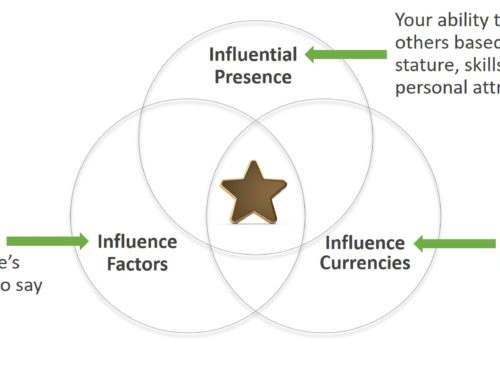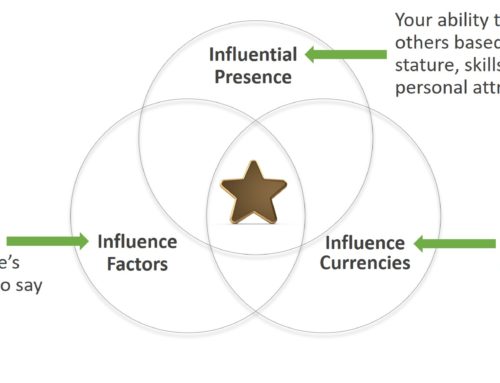Saying no is an often-overlooked influence technique. It is not simply saying no; it’s saying no and suggesting you or the other person/people involved do something differently. For example, someone asks you to give them a recap of a meeting they missed, but you don’t have time to do so. Rather than just saying no, you could use a leading question, saying, “I’d like to help, but I’m afraid I might accidentally leave out an important point. Did you know that the meeting’s minutes are available online in the meeting notes? Do you think it would be better to look there?” This type of technique has the dual benefits of saving you from having to spend time recapping the meeting and simultaneously redirects the person to a place where they can get the needed information.
Using these types of “redirection techniques” can save you from:
- Feeling confrontational by saying no.
- Offending non-IT business partners
- Agreeing to perform work you don’t want to do.
- Wanting to help but not having the needed time, information, and/or resources to provide assistance.
The topics/techniques that follow are alternative ways to say no without actually saying no by either providing alternatives or redirecting the question.
1. Saying No Using Redirection
This technique is best when you are willing to help but believe what they are asking you to do either won’t work or you would rather do it a different way. In this case, your reply should provide an alternative solution, such as:
- I’m sorry I won’t be able to help you with that technology, but perhaps I could….
- I don’t think that software will work, but….
- Have you considered this instead…?
- I’m afraid that I can’t legally install that software, but can I suggest….
2. Saying No by Redirecting Work Back to the Requestor
This technique is best when someone comes to you with a big idea for something they would like done but they want you to do all the work. In addition to the workplace, this often happens when you are in a volunteer role within a non-profit, religious, or other charitable organization. The person making the request is often a fellow volunteer or able-bodied recipient of the service.
When confronted with this type of request, respond with, “Interesting. Would you like to lead a volunteer committee to research this?” When posed with this question, one of two things will happen. The person will either agree to help, which is great, or will go away and leave you alone.
3. Saying No Using Referral
This technique is best when you’re willing to provide assistance, but someone other than you could do a better job, or you need permission to perform the task. In the first case, refer them to the person best able to assist them. In the second case, ask that they speak with your boss to gain permission. The following two replies can be used respectively:
- I’m not the best person to help on this. Can I suggest you speak with…?
- I’m happy to help you, but you’ll have to get my boss’ okay first.
4. Saying No Using the Company High Road
This technique is best when you feel uncomfortable saying no but know you should. This technique allows you say no using the delegated authority of those higher than you within your organization. In other words, you are basically saying that you would like to help but can’t. Therefore, they will go away disappointed but not mad at you because it was not your decision. The following examples can be used when this situation arises. Modify them based on your job type and the request made.
- Sorry; I’d love to help, but I’ve already promised to help on another project and don’t have time to do both projects.
- Sorry; I’d love to help, but I’m spending all my time on the software for the company’s new marketing initiative.
- Sorry; I can’t. The CIO told me to spend as much time as possible on this new cloud-based project because it’s really important to our new computing platform.
5. Avoiding the Question
Sometimes the best way to say no is to make sure the question is never asked.
To avoid being asked the question at all, use a gatekeeper to keep people away. This is a common practice used by busy executives to reduce their level of distraction. Your gatekeeper could be an administrative assistant who screens your incoming calls and handles your schedule. If this isn’t available to you, you can easily screen your own incoming calls via caller identification and send numbers/people you’re not familiar with or would rather avoid to voice mail.
6. Saying No Through Process
At times, you may find yourself saying no to the same question repeatedly. The danger of this scenario is that it could hurt your professional reputation by making it look like you are not a team player. If this is happening to you, create a policy that says no or a prioritization process that always seems to place this type of request at the bottom of the list.
The logic behind this concept is it allows you to deflect the blame from yourself to the policy or a previously approved prioritization process. This technique sends people with redundant requests away disappointed but not mad at you.
7. Saying No Using Leading Questions
Leading questions are questions that point the asker in a specified direction. In effect, you are telling them to do something, but because it’s in the form of a question, it feels much softer and helpful, rather than confrontational. These examples can be modified based on your job type and the likely requests:
- Did you know that Pat is much more knowledgeable in that technology than I am?
- Did you know that this data is available online on the website?
- Did you know that the website does a great job describing the needed steps?
8. Being Vague and Noncommittal
This technique is used within many cultures as an acceptable way to say no. In effect, you are saying no by not saying yes. Examples of how to do this include:
- Hmmm, interesting. Let me think about it, and I’ll let you know.
- I won’t have the time for a month or two. Could you ask me again then?
- Those dates don’t work for me. Can you please send me other potential dates?
- My calendar is already full, but if something opens up, I’ll give you a call.
- I’d like to help you, but I don’t know how. I’ll call if I think of something good.
If you use this technique, be careful that the person doesn’t misinterpret your comment and think you have agreed to assist them. If they do, it could very embarrassing for both you and requestor when the person returns looking for results.
As an additional point, it’s important for you to understand that this cultural norm exists in case someone says this to you.
9. Saying Yes with Conditions
This technique is best when you are willing to help but want either assistance or something specific in return. In this case, reply in the following way:
- Yes, but to make that work, I’ll need….
- Yes, but I’ll need help from Mary on….
- Yes, if you are willing to providing the following….
- Yes, if I can delay another required task such as….
- Yes, if I can…(get something of value out of it).
Final Thought
Don’t underestimate the importance of saying no in a non-offensive and constructive way. Over the course of your career, your professional reputation is not only defined by your achievements; it’s also based on your willingness to help your coworkers and how you treated them during the process.




